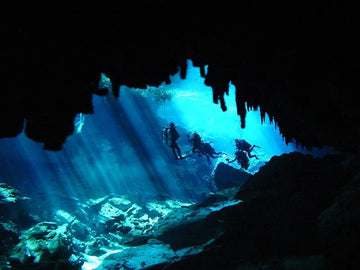Diving in the cenotes of Yucatán is a unique experience. There's nothing that can compare to this type of diving. On one hand, you are diving in freshwater through stalactites and stalagmites that nature has patiently sculpted over millions of years. On the other hand, you are in a sacred place for one of the longest civilizations to ever exist, the Maya. For them, cenotes were a source of life from which they obtained freshwater. Cenotes were so important to the Maya that for centuries, they have been offering human sacrifices to thank the gods for providing them with freshwater.
Are you a diver and an ocean lover? These T-shirts are for you >>>
A cenote is a depression in the rock filled with freshwater that, due to erosion or the collapse of the surface, has opened a hole in a cave providing access from the outside. In Mexico, only in the Yucatán Peninsula, we can find more than 3,000 of these geological formations. And the most interesting thing about them is that they can be explored by diving.
Unlike other types of diving in Mexico where the highlight is its fauna and flora, the appeal of diving in cenotes is both its history and the geological formations, as well as the incredible light we can enjoy. Thousands of different shades of blue, beautiful reflections of sunlight, or the spectacular changes in density and color of the water produced by haloclines (a mix of freshwater and saltwater) are the stars of this type of immersion.
While cenote diving is very popular, and thousands of divers access them each year, it is not suitable for novice divers as it requires some experience. Control of position and buoyancy are very important as there are constant ascents and descents throughout the dive. We must maintain a perfectly horizontal position, avoiding the legs from falling and stirring up sediment from the cave floor. The better divers we are, the more we will enjoy this spectacle, and the impact we will have on this wonder of nature will be less.
Cenote Chac-Mool
This cenote has two rooms, the first is relatively large and receives extraordinary light that provides a thousand changing reflections. In the second room, part of the ceiling has collapsed under an air dome where divers can emerge to enjoy two different levels of beautiful stalactites. This cenote houses the largest underwater stalactite in the world, measuring 13 meters in length.
Along the opening of the main entrance, we can dive among trunks and branches of trees that have managed to make their way through the rocks to obtain moisture. The "laser beam" show that occurs in this cenote on sunny days is incredible. In addition to this, there are the haloclines of this cenote that produce fascinating visual effects.
Cenote Kukulcan
This cenote has unique light effects that seem unbelievable to occur naturally. Access to Cenote Kukulkan is through a beautiful pond at one end of the cenote. A few meters away is a halocline where we recommend directing the light from your flashlight to admire the reflections projected on the walls of the cavern. The light effects of this cenote are impressive; look towards the ceiling of the entrance and take some time to admire the colors of the rainbow.
Cenote Dos Ojos
Cenote Dos Ojos is probably the most popular cenote in Mexico. This popularity has been achieved by being accessible to all types of divers due to its shallow depth, allowing for amazing light effects through the entrance of light, a long bottom time for more enjoyment of the dive, and beautiful stalagmites and stalactites that decorate the entire system. Dos Ojos has two openings to the cave very close to each other. This cenote ensures excellent visibility and spectacular light effects, especially in the second eye.
Cenote El Edén
The first thing we find when we arrive at this cenote (also known as Ponde Rosa) is a huge surface of water that makes us think they have placed a giant pool in the middle of the jungle. The different caves in this cenote are home to many tropical fish and eels that swim around fossilized corals in this water with almost infinite visibility. Here, we can admire a halocline that extends up to 10 meters, and technical divers and cave enthusiasts have a place to explore many caves. It is a paradise not only for divers but also for those who want to experience the incredible sensation of swimming in a sacred place surrounded by rocks and jungle trees.
Cenote Chickin-Ha
The Cenote Chikin-Ha connects several cenotes through a system of over 10 kilometers of underwater passages. Reaching a depth of 10 meters, we can find another extraordinary halocline that will not only impress us with the beauty of light-contrasts but also with different temperature, buoyancy, and even taste! In this cenote, the amazing roots of centuries-old trees that have struggled with the rocks for years to carve out a space among them also stand out. On sunny days, unique light effects occur between the cenotes.





















